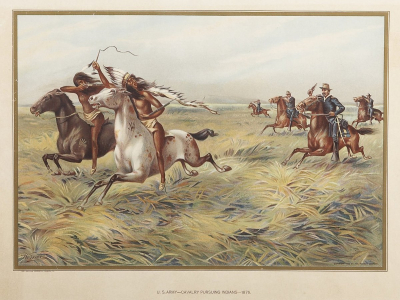The Battle of the Little Bighorn, known to the Lakota and other Plains Indians as the Battle of the Greasy Grass, and also commonly referred to as Custer's Last Stand, was an armed engagement between combined forces of the Lakota Sioux, Northern Cheyenne, and Arapaho tribes and the 7th Cavalry Regiment of the United States Army. The battle, which resulted in the defeat of U.S. forces, was the most significant action of the Great Sioux War of 1876. It took place on June 2526, 1876, along the Little Bighorn River in the Crow Indian Reservation in southeastern Montana Territory.The Battle of the Little Bighorn (14 on the map to the right), like most battles in the Great Sioux War "were on lands those Indians had taken from other tribes since 1851". The Lakotas were there without consent from the local Crow tribe, which had treaty on the area. Already in 1873, Crow chief Blackfoot had called for U.S. military actions against the Indian intruders. The steady Lakota invasion (a reaction to encroachment in the Black Hills) into treaty areas belonging to the smaller tribes ensured the United States a firm Indian alliance with the Arikaras and the Crows during the Lakota Wars.The fight was an overwhelming victory for the Lakota, Northern Cheyenne, and Arapaho, who were led by several major war leaders, including Crazy Horse and Chief Gall, and had been inspired by the visions of Sitting Bull (Tatka yotake). The U.S. 7th Cavalry, a force of 700 men, suffered a major defeat while commanded by Lieutenant Colonel George Armstrong Custer (formerly a brevetted major general during the American Civil War). Five of the 7th Cavalry's twelve companies were wiped out and Custer was killed, as were two of his brothers, a nephew, and a brother-in-law. The total U.S. casualty count included 268 dead and 55 severely wounded (six died later from their wounds),:244 including four Crow Indian scouts and at least two Arikara Indian scouts.
Public response to the Great Sioux War varied in the immediate aftermath of the battle. Libbie Custer, Custer's widow, soon worked to burnish her husband's memory, and during the following decades Custer and his troops came to be considered heroic figures in American history. The battle, and Custer's actions in particular, have been studied extensively by historians. Little Bighorn Battlefield National Monument honors those who fought on both sides.
The American Indian Wars, also known as the American Frontier Wars, the First Nations Wars in Canada (French: Guerres des Premières Nations), and the Indian Wars, were fought by European governments and colonists in North America, and later by the United States and Canadian governments and American and Canadian settlers, against various American Indian and First Nation tribes. These conflicts occurred in North America from the time of the earliest colonial settlements in the 17th century until the early 20th century. The various wars resulted from a wide variety of factors. The European powers and their colonies also enlisted allied Indian tribes to help them conduct warfare against each other's colonial settlements. After the American Revolution, many conflicts were local to specific states or regions and frequently involved disputes over land use; some entailed cycles of violent reprisal.
As settlers spread westward across North America after 1780, armed conflicts increased in size, duration, and intensity between settlers and various Indian and First Nation tribes. The climax came in the War of 1812, when major Indian coalitions in the Midwest and the South fought against the United States and lost. Conflict with settlers became much less common and was usually resolved by treaty, often through sale or exchange of territory between the federal government and specific tribes. The Indian Removal Act of 1830 authorized the American government to enforce Indian removal from east of the Mississippi River to Indian Territory west on the American frontier, especially what became Oklahoma. The federal policy of removal was eventually refined in the West, as American settlers kept expanding their territories, to relocate Indian tribes to reservations.

1876Nov, 25
American Indian Wars: In retaliation for the American defeat at the Battle of the Little Bighorn, United States Army troops sack the sleeping village of Cheyenne Chief Dull Knife at the headwaters of the Powder River.
Choose Another Date
Events on 1876
- 2Feb
Major League Baseball
The National League of Professional Baseball Clubs of Major League Baseball is formed. - 10Mar
Alexander Graham Bell
The first successful test of a telephone is made by Alexander Graham Bell. - 22Apr
MLB
The first game in the history of the National League was played at the Jefferson Street Grounds in Philadelphia. This game is often pointed to as the beginning of the MLB. - 4Jun
First Transcontinental Railroad
An express train called the Transcontinental Express arrives in San Francisco, via the First Transcontinental Railroad only 83 hours and 39 minutes after leaving New York City. - 25Nov
Battle of the Little Bighorn
American Indian Wars: In retaliation for the American defeat at the Battle of the Little Bighorn, United States Army troops sack the sleeping village of Cheyenne Chief Dull Knife at the headwaters of the Powder River.

 English
English  español
español  français
français  português
português  русский
русский  العربية
العربية  简体中文
简体中文 